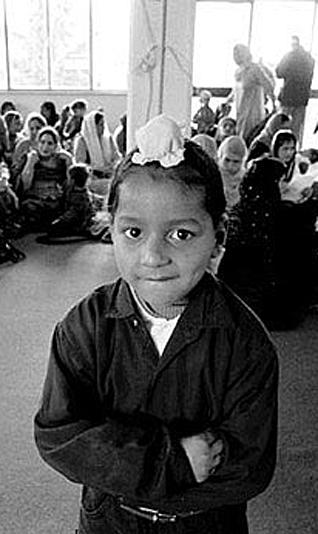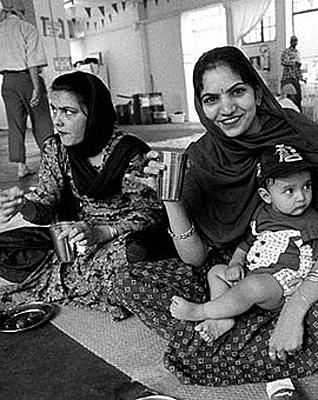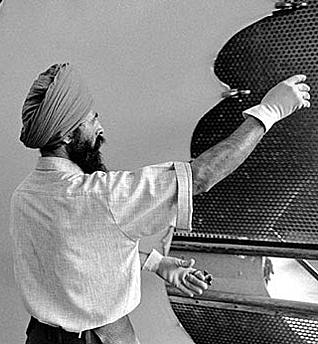Alongside common local last names like Ferrari and Galli, the telephone directories for the province of Cremona have been registering an increasingly present surname: Singh.
For the past 20 years, Sikh immigrants from Punjab have been settling in Italy’s agricultural heartland to work primarily on farms, often as bergamini, as dairy workers are known in the native dialect.
It has been said that if the Sikh workers went on strike, production of Grana Padano, the hard, grainy, spaghetti-topper that this tract of the Po Valley is known for, would shut down.
“Well, I don’t know if production would stop, but it would certainly create many difficulties,” said Simone Solfanelli, the president of the Cremona chapter of Coldiretti, Italy’s largest agricultural organization. “I can tell you that they are indispensable for farming,” and for the milk produced in the province - at one million tons per year, about a tenth of all milk produced in Italy, he added.
These new Sikh-Italians first arrived in the area just as a generation of dairy workers was retiring, with no substitutes in sight.
“They saved an economy that would have gone to the dogs because young people didn’t want to work with cows,” Mayor Dalido Malaggi of Pessina Cremonese said. Though the dairy industry is mostly mechanized today, human labor is still necessary 365 days a year, he explained.
The work is split in two four-hour shifts per day, about 12 hours apart. “Young Italians don’t want to work those kinds of hours,” he said. “They’d prefer to work in factories and have evenings and weekends free.”
It was a fortunate match, because many of the immigrants already knew what it took to keep a farm running.
“This is dairy land, and many of us have cows in Punjab,” said Jaswinder Singh Duhra, who has lived in Italy for 25 years, working first as a bergamino and then for one of Italy’s best-known cheese manufacturers. “We’re used to the work that we do here.”
There are no official statistics of how many Sikhs work in dairy barns here, but Mr. Solfanelli said that of the 3,000 agricultural laborers in the province, about a third are Sikh.
One measure of their presence was the inauguration last month of the Gurduwara Sri Guru Kalgidhar Sahib, a Sikh place of worship designed to hold 600 comfortably (thought at least six times as many people attended the opening ceremony on August 21). It has been touted as the largest gurdwara in Continental Europe.
Built in an industrial area that includes a factory of vacuum pump compressors and a cold-cut production plant, the gurdwara was inspired by Sikh models in Punjab “but is both a monument and a center for the community,” said its designer, Giorgio Mantovani. (Other gurdwaras in the vicinity have been located in repurposed poultry farms or warehouses.)
The road from the drawing board to the gleaming white structure that rises amid soya and corn fields was not without its rocky patches.
Municipal permits were given and withdrawn in a nearby town when the gurdwara became a politically thorny issue, so another site was found. A decade’s worth of bureaucratic hurdles also had to be overcome, money had to be raised by the Sikh community, and loans found to make up the rest of the price tag of €2 million, or nearly $3 million. “It took years, but we all pitched in as best we could,” Jaswinder Singh said.
The gurdwara is still missing a fountain in front of the entrance and the gilded cupolas that characterize Sikh architecture. The latter have been a matter of some concern, because Cremona’s clammy, foggy winters “make gold a bad choice,” Mayor Malaggi said. Various other construction materials are being considered.
While the mayor was an active supporter of the gurdwara, and the road sign into town proudly proclaims Pessina Cremonese to be “free from racial prejudices,” there was some opposition from local politicians with the Northern League, the political party most closely associated with anti-immigrant oratory in Italy. A small group of protesters from Forza Nuova, an extreme right party, demonstrated when the gurdwara opened.
Manuel Gelmini, a Northern League lawmaker in Cremona’s provincial council who unsuccessfully tried to block the building of the gurdwara, said his main concern was the kirpan, the article of faith carried by fully-practicing Sikhs. “For us, it’s a weapon, and people shouldn’t be allowed to go around armed,” he said.
He also objected to the use of Punjabi as the lingua franca in the gurdwara. “They live in Lombardy,” he said. “How can there be integration if we allow them to speak their own language in a public space?”
But tellingly, the Northern League has not campaigned openly against the Sikh immigrants working as bergamini. “As long as they respect our laws, work legally and learn Italian, they are welcome in our country,” Mr. Gelmini said.
Dilbagh Singh arrived in Italy when he was 14, and now, 12 years later, he speaks with the distinctive accent of his adopted hometown, Nogara, near Mantua. He said his compatriots “come here to work, and want to live peacefully.” To this end, Dilbagh Singh runs a Web site on Sikhs in Italy so that “Italians can understand us.”
“We want people to know who we are,” he said.
Nearly 16,000 Sikh immigrants are legally employed in agriculture in Italy, with the Lazio region becoming the newest pole of , especially for seasonal workers. “You only have to travel 100 kilometers from Rome to discover a world most people don’t even know exists,” said Patrizia Santangelo, a filmmaker whose documentary about the Sikh community in the province of Latina, “Visit India,” is to have its premiere in October.
Ms. Santangelo’s documentary exposes some of the exploitation that many immigrant workers are subject to, regardless of their provenance.
“They often live in camps, like homeless people, and can get paid low wages, 2 to 4 euros an hour for 12-hour days,” she said. “But what struck me is that even though they live in difficult conditions, the [Sikh] workers are still able to see the positive side of situations.”
In the north, life seems less harsh, at least on the surface. Many of the Sikh immigrants have become Italian citizens. Many have bought homes and settled their families here.
According to the national statistics agency, about 40 percent of all Sikh immigrants to Italy are women, but only a small percentage have jobs. In the case of Pessina Cremonese, concerns about their isolation have been sporadically addressed with Italian lessons and work-training programs, and labor unions have offered similar programs in other towns.
Many of the Sikh immigrants have also raised children in Italy, who imagine a different future.
“They work hard at school; they’re not spoiled like our kids,” said Gianluigi Fiamenghi, who employs seven Sikh-Italian workers on his dairy farm of 1,700 cows. “And their children won’t want to work on a farm, they’ll go to university and want to get ahead.”
One of Mr. Fiamenghi’s workers, Prem Singh, moved to Italy in 1995, and many of his relatives followed. He and his wife are raising three children now in primary school. “They feel more Italian than Indian,” he said, adding that he had no plans to return to his native land. “We’ve put down our roots here. It’s our home, and that’s that.”
[Courtesy: New York Times. Edited for sikhchic.com]
September 10, 2011






